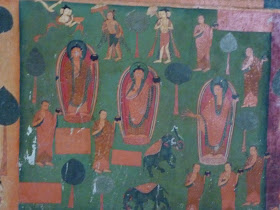Without any doubt at all the highlight of my Tibet trip was visiting the Lhakhang Karpo, White Chaple in Tsaparang. Over the years I have been privileged, I might even say blessed, to have seen nearly all the great Buddhist monuments in the world except those in Korea and Japan, and I would have to say that nothing I have ever seen compares to the glorious Lhakhang Karpo. I stood in silent awe at the exquisite paintings of the Buddha and bodhisattvas. Even the images of the Tantric deities left me speechless. On the right side of the chapel on the lower edge of the paintings is a series of panels depicting events in the life of the Buddha, which even in this treasure house of art stand out as superlative. I have not been able to find out when they were painted but the Indian/Newari influence is most noticeable so they must be very old – I’ll say 13th century. The colors are stunning and so shiny their surface, that they look like they could have been painted yesterday. Most amazing of all I was able to recognize most of the events they depicted. It thrilled my to think that people in this most remote place eight or nine hundred years ago, outwardly so different from me, read or heard and connected with the same things I do now. The Dhamma is truly timeless (akaliko). I took of some of these panels. Some of them are of poor quality but the light was poor and I’m not such a good photographer so I’m sure you’ll forgive me. (1) The Bodhisattva practicing austerities. Note the cowherd boys poking sticks in his ears as mentioned in the Majjhima Nikaya. (2) The Temptation of Mara. I cannot figure out what the object on the pedestal below the Buddha is meant to be. (3) Enlightenment. (4) The gods giving the Buddha a crystal bowl. (5) The First Sermon. I cannot identify (6), (7) and (8). (9) Floral decoration. (10) The Parinirvana and the cremation of the Buddha’s body. (11) The first eight stupas. 





















Venerable,
ReplyDeleteI would hazard a guess at number 8 being a depiction of the Buddha subduing the drunken elephant sent by Devadatta to harm the Buddha.
As for the stupas, they reflect the out types of stupas in the Tibetan tradition, commemorating the eight major events in the Buddha's life (from the Tibetan POV), being the Buddha's birth, enlightenment, first teaching, descent from Tushita, reconcilation of the Sangha (after Devadatta's schism, I think), performance of miracles (either the Twin miracle or more probably, the 15 miracle as celebrated by the Monlam Chenmo), the extension of his lifespan at the request of his disciples and the Buddha's parinirvana.
Bhante,
ReplyDeleteWhat is the story behind the boys who poke the Bodhisattva with sticks in his ears? Could you tell me the source?
Thanks,
Ben
Dear JMLee,
ReplyDeleteYou are quite correct. Actually, I meant to include three unidentified pictures and have inadvertently posted this one without noticing it until you have just now drawn my attention to it. Concerning for the eight stupas, as they are located at the very end of the series, after the Buddha’s cremation, I’m fairly certain they represent the stupas erected over the Buddha’s relics.
Dear Ben,
At Majjhima Nikaya I,79 the Buddha said that during the time he practiced self-mortifications his indifference was so strong that when some naughty cowherd boys spat on him, urinated on him, threw dirt on him and poked twigs in his ears, he remained unmoved. Interestingly, this same ‘abuse’ is said to have happened to Mahavira, the founder of Jainism, and the ‘twigs in the ears’ incident is often depicted in Jain art.